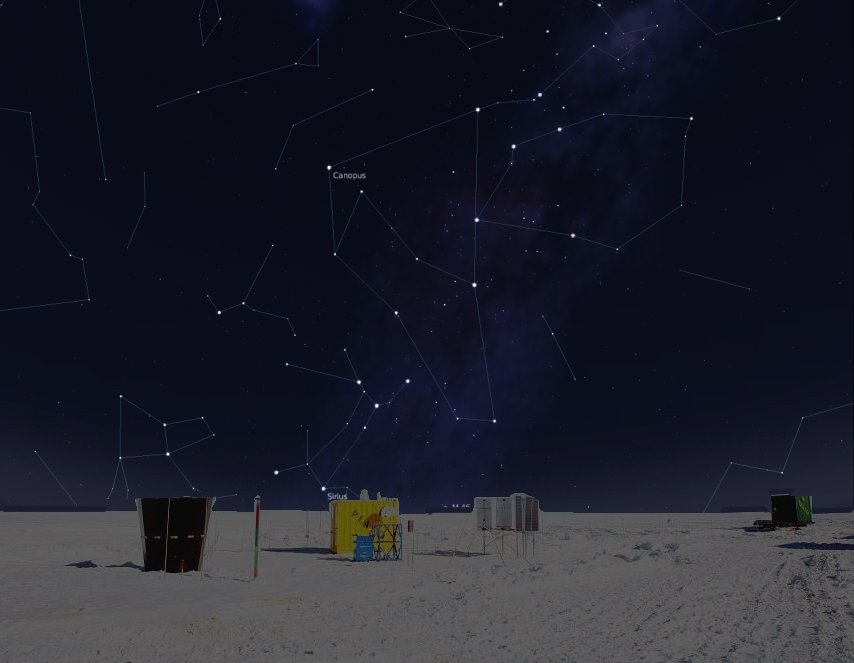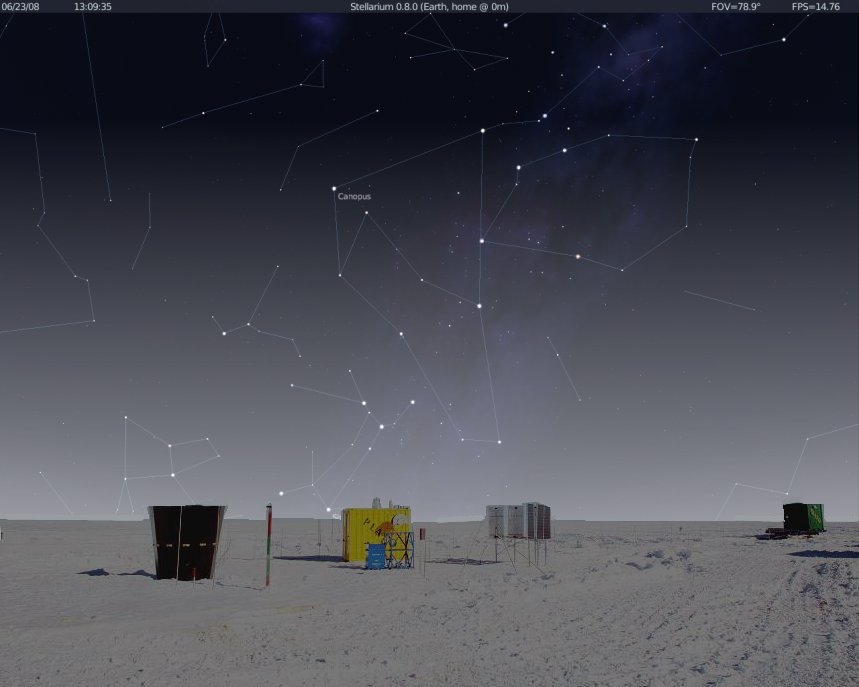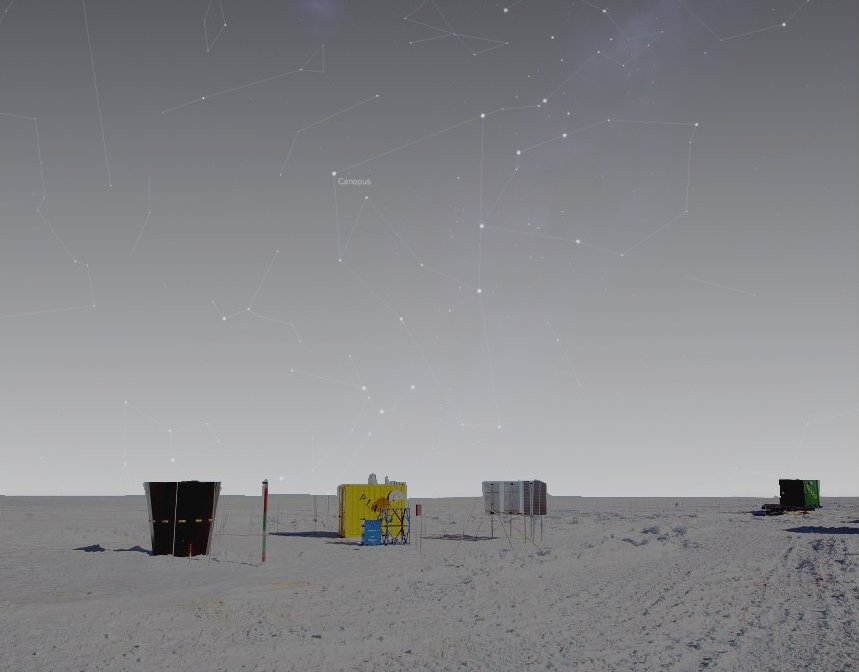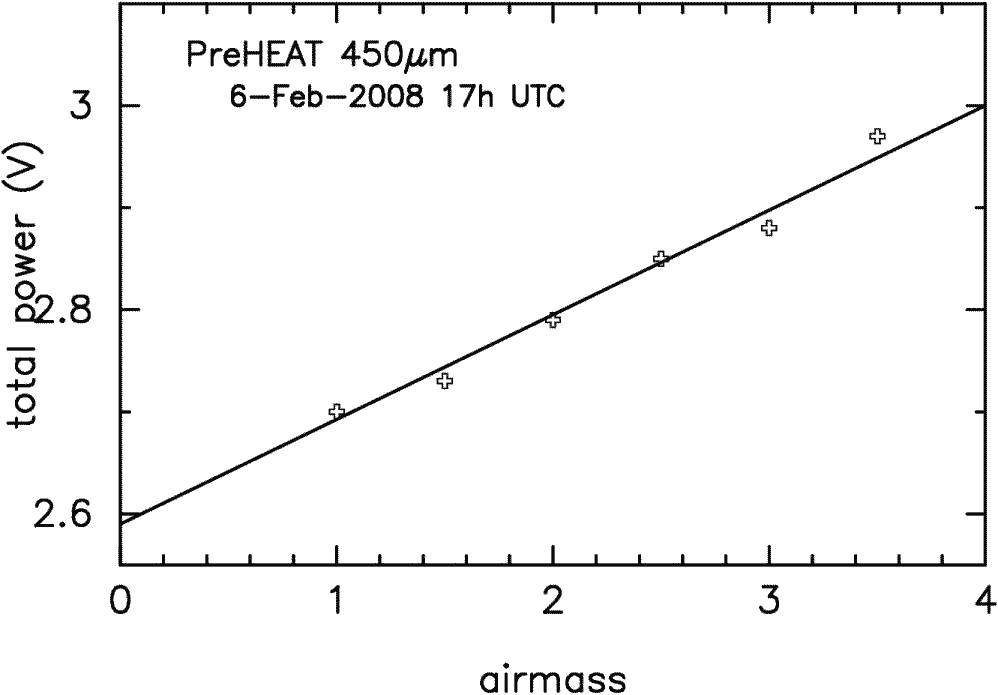Pre-HEAT

Pre-HEAT telescope integrated onto PLATO in Sydney
The submillimeter-wave instrument on the original PLATO was called Pre-HEAT. Its name reflected that it was a prototype for the HEAT (High Elevation Antarctic Terahertz) telescope, a larger, more sophisticated telescope which was deployed in January 2012 at Ridge A, some 150km from Dome A. Pre-HEAT performed astronomical observations and measured the transparency of the sky above Dome A during 2008 at submillimeter wavelengths using a high frequency heterodyne receiver. The principles behind the operation of Pre-HEAT's heterodyne receiver are very similar to an ordinary FM radio. However, the Pre-HEAT receiver is many orders of magnitude more sensitive and is operating at frequencies that are 6600 times higher—660 GHz, or equivalently 0.66 THz.
Pre-HEAT completed its measurements in 2008, during the first year of operation of PLATO. The data showed extraordinarily low values of precipitable water vapour in the atmosphere. See the section on Refereed Publications below.
Why Submillimeter Astronomy?
Of the many varied "colors" in the electromagnetic spectrum of light, submillimeter waves are perhaps the last unexplored frontier. Nestled between traditional radio astronomy and optical/infrared astronomy, the submillimeter part of the spectrum is one of the richest treasure-troves for understanding the cold gas in galaxies that gives rise to the formation of stars and planets. On a larger scale, distant galaxies give off prodigious amounts of thermal energy at submillimeter wavelengths. It is possible that the oldest and most distant galaxies in the Universe will be detected at submillimeter wavelengths.The submillimeter-wave Universe has gone mostly unexplored because of the difficulty of instrumentation, and the fact that even minute traces of water vapor in the air absorb submillimeter light from space before reaching the ground. Thus, submillimeter-wave telescopes must be placed on the highest, driest sites on the planet. Large telescopes have already been placed on sites like Mauna Kea, Hawaii and (increasingly) on the high plains of the Atacama desert in northern Chile. However, because cold air holds less water vapor than warm air, expectations are that the high plateau of Antarctica will be even better, due to the extreme conditions which prevail there.
This was the motivation for building the prototype Pre-HEAT telescope for PLATO.
Site Testing
To measure the transparency of the sky above Dome A, the Pre-HEAT telescope scanned the sky in elevation while measuring its brightness. The following sketches depict what Pre-HEAT would saw in three different weather scenarios:
Data collection began on 24 January 2008, with fully automated operation beginning in early March. Aside from some loss of receiver sensitivity compared to lab tests in Sydney, the instrument worked well throughout 2008, and provided good measurements of the submillimeter sky over Dome A. Below is a single data measurement from early February, demonstrating that even in comparatively poor summer weather, the atmospheric transparency above Dome A is exceptional! In this single example, if you were to collect all of the water vapor over Dome A and condense it into an ocean, it would be only 0.22 millimeters deep. During the depths of the Antarctic winter, the conditions became better still.
Astronomical Measurements
Pre-HEAT is a complete submillimeter-wave observatory. Not only does Pre-HEAT measure the atmosphere above Dome A, but it is also capable of performing detailed astronomical observations. Over the course of the season, Pre-HEAT performed spectroscopic observations of the plane of the Milky Way in the light of the carbon monoxide (CO) molecule, our best tracer of the dark, cold clouds of gas and dust in interstellar space from which all stars are born.Pre-HEAT's surveys will lead the way toward the even higher frequency surveys of atomic carbon, ionized carbon, ionized nitrogen, and CO being performed by the follow-on HEAT telescope, which will help us understand how molecular clouds themselves are born in our Galaxy. Since we as human beings were an eventual product of these clouds' evolution, the mystery that Pre-HEAT and HEAT will help solve is a part of the story of our own origins!
 |
This infrared image of the Milky Way, taken by the 2MASS survey, shows the rich assemblage of stars, dust and gas that comprises our Milky Way Galaxy. Pre-HEAT detected regions where cold and dark molecular clouds gave birth to new stars, and the follow-on HEAT telescope will learn how these clouds are made! |
Learn more!
The main web site for the current status of Pre-HEAT and information about HEAT is:
http://soral.as.arizona.edu/heat/
Refereed papers
- Burton, M. G., Ashley, M. C. B., Braiding, C., Storey, J. W. V., Kulesa, C., Hollenbach, D. J., Wolfire, M., Gluck, C., Rowell, G., 2014, The Carbon Inventory in a Quiescent, Filamentary Molecular Cloud in G328, Astrophysical Journal, 782, 72.
- Yang, H., Kulesa, C. A., Walker, C. K., Tothill, N. F. H., Yang, J., Ashley, M. C. B., Cue, X., Feng, L., Lawrence, J. S., Luong-Van, D. M., McCaughrean, M. J., Storey, J. W. V., Wang, L., Zhou, X., and Zhu, Z., 2010, Exceptional terahertz transparency and stability above Dome A, Antarctica, Publications of the Astronomical Society of the Pacific, 122, (2010), 490–494.
SPIE instrumentation papers
- C.A. Kulesa, C.K. Walker, M. Schein, D. Golish, N. Tothill, P. Siegel, S. Wienreb, G. Jonees, J. Bardin, K. Jacobs, C.L. Martin, J.W.V. Storey, M. Ashley, J. Lawrence, D. Luong-Van, J. Everett, L. Wang, L. Feng, Z. Zhu, J. Yan, J. Yang, X.G. Zhang, X. Cui., X. Yuan, J. Hu, Z. Xu, Z. Jiang, H. Yang, Y. Li, B. Sun, B. and Z, Shang, Pre-HEAT: Submillimeter Site Testing and Astronomical Spectra from Dome A, Antarctica, Proc. SPIE, 7012, (2008), 701249–701249-11.
Conference proceedings
- Tothill, N. F. H., Kulesa, C. A., Walker, C. K., Yang, J., Ashley, M. C. B., Lawrence, J. S., Luong-van, D., Storey, J. W. V., Yang, H., Zhou, X., Zhu, Z., Bardin, J., Cui, X., Everett, J., Feng, L., Golish, D., Gong, X., Hu, J., Jacobs, K., Jiang, Z., Jones, G., Li, Y., Martin, C. L., McCaughrean, M. J., Qin, W., Schein, M., Shang, Z., Siegel, P., Sun, B., Walsh, W., Wang, L., Weinreb, S., Xu, Z., Yan, J., Yuan, X., Zhang, X.-G., 2010, THz Astrophysics from Dome A, EAS Publications Series, 40, 275–280.
- N.F.H. Tothill, C.A. Kulesa, C.K. Walker, M.C.B. Ashley, C. Bonner, X. Cui, J. Everett, Feng, L., S. Hengst, Hu, J., Jiang, Z., J.S. Lawrence, Li, Y., D. Luong-Van, A. M. Moore, Pennypacker, C., Qin, W., R. Riddle, J.W.V. Storey, Shang, Z., Sun, B., T. Travouillon, L. Wang, Z. Xu, H. Yang, J. Yan, D. York, X. Yuan, and Z. Zhu, Astrophysics from Dome A, EAS Publications Series, 33, (2007), 301–306.
Contacts
Craig Kulesa at the University
of Arizona, Tucson (USA)
Chris Walker at the University
of Arizona, Tucson (USA)
Mark McCaughrean at the University
of Exeter (UK)
Nick Tothill at the University
of Exeter (UK)
Participating institutions in alphabetical order
 |
Pre-HEAT was made possible by a Small Grant for Exploratory Research (SGER) from the National Science Foundation (ANT-0735854). |
 |
European Commission (Sixth Framework Programme - grant MIRG-CT-2006-044961) |
 |
Purple Mountain Observatory, China |
 |
University of Arizona, USA |
 |
University of Exeter, UK |
 |
University of New South Wales, Australia |





